Nitridation Temperature Effect on Carbon Vanadium Oxynitrides for a Symmetric Supercapacitor
Abstract
1. Introduction
2. Experimental
2.1. Synthesis of C-V2NO Nanomaterials by Thermal Decomposition Technique
2.2. Structure, Morphology and Composition Characterization
2.3. Electrochemical Characterization of C-V2NO Electrodes
3. Results and Discussion
Electrochemical Performance
4. Conclusions
Supplementary Materials
Author Contributions
Funding
Conflicts of Interest
References
- Surendran, S.; Shanmugapriya, S.; Shanmugam, S.; Vasylechko, L.; Kalai Selvan, R. Interweaved Nickel Phosphide Sponge as an Electrode for Flexible Supercapattery and Water Splitting Applications. ACS Appl. Energy Mater. 2018, 1, 78–92. [Google Scholar] [CrossRef]
- Huang, P.; Lethien, C.; Pinaud, S.; Brousse, K.; Laloo, R.; Turq, V.; Respaud, M.; Demortiere, A.; Daffos, B.; Taberna, P.L.; et al. On-chip and freestanding elastic carbon films for micro-supercapacitors. Science 2016, 351, 691–695. [Google Scholar] [CrossRef] [PubMed]
- Kang, Y.J.; Chung, H.; Han, C.-H.; Kim, W. All-solid-state flexible supercapacitors based on papers coated with carbon nanotubes and ionic-liquid-based gel electrolytes. Nanotechnology 2012, 23, 065401. [Google Scholar] [CrossRef] [PubMed]
- Su, F.; Miao, M. Asymmetric carbon nanotube–MnO2 two-ply yarn supercapacitors for wearable electronics. Nanotechnology 2014, 25, 135401. [Google Scholar] [CrossRef] [PubMed]
- Deng, L.; Zhang, G.; Kang, L.; Lei, Z.; Liu, C.; Liu, Z.-H.H. Graphene/VO2 hybrid material for high performance electrochemical capacitor. Electrochim. Acta 2013, 112, 448–457. [Google Scholar] [CrossRef]
- Simon, P.; Gogotsi, Y. Materials for electrochemical capacitors. Nat. Mater. 2008, 7, 845–854. [Google Scholar] [CrossRef]
- Yu, L.; Chen, G.Z. High energy supercapattery with an ionic liquid solution of LiClO 4. Faraday Discuss. 2016, 190, 231–240. [Google Scholar] [CrossRef]
- Yu, L.; Chen, G.Z. Redox electrode materials for supercapatteries. J. Power Sour. 2016, 326, 604–612. [Google Scholar] [CrossRef]
- Zhi, M.; Xiang, C.; Li, J.; Li, M.; Wu, N. Nanostructured carbon–metal oxide composite electrodes for supercapacitors: a review. Nanoscale 2013, 5, 72–88. [Google Scholar] [CrossRef]
- Silversmit, G.; Depla, D.; Poelman, H.; Marin, G.B.; De Gryse, R. Determination of the V2p XPS binding energies for different vanadium oxidation states (V5+ to V0+). J. Electron Spectrosc. Relat. Phenom. 2004, 135, 167–175. [Google Scholar] [CrossRef]
- Cherusseri, J.; Sambath Kumar, K.; Choudhary, N.; Nagaiah, N.; Jung, Y.; Roy, T.; Thomas, J. Novel mesoporous electrode materials for symmetric, asymmetric and hybrid supercapacitors. Nanotechnology 2019, 30, 202001. [Google Scholar] [CrossRef] [PubMed]
- Yu, J.; Gao, X.; Cui, Z.; Jiao, Y.; Zhang, Q.; Dong, H.; Yu, L.; Dong, L. Facile Synthesis of Binary Transition Metal Sulfide Tubes Derived from NiCo-MOF-74 for High-Performance Supercapacitors. Energy Technol. 2019, 7, 1900018. [Google Scholar] [CrossRef]
- He, T.; Wang, Z.; Li, X.; Tan, Y.; Liu, Y.; Kong, L.; Kang, L.; Chen, C.; Ran, F. Intercalation structure of vanadium nitride nanoparticles growing on graphene surface toward high negative active material for supercapacitor utilization. J. Alloys Compd. 2019, 781, 1054–1058. [Google Scholar] [CrossRef]
- Kumar, U.N.; Ghosh, S.; Thomas, T. Metal Oxynitrides as Promising Electrode Materials for Supercapacitor Applications. ChemElectroChem 2019, 6, 1255–1272. [Google Scholar] [CrossRef]
- Zheng, S.; Gao, L. Nanosized Titanium Oxynitride and Molybdenum Oxynitride Particles Assembled in Mesoporous Silica MCM-41. Mater. Sci. Forum 2006, 510–511, 138–141. [Google Scholar] [CrossRef]
- Zhao, Y.M.; Hu, W.B.; Xia, Y.D.; Smith, E.F.; Zhu, Y.Q.; Dunnill, C.W.; Gregory, D.H. Preparation and characterization of tungsten oxynitride nanowires. J. Mater. Chem. 2007, 17, 4436. [Google Scholar] [CrossRef]
- Zheng, Q.; Kvit, A.; Cai, Z.; Ma, Z.; Gong, S. A freestanding cellulose nanofibril–reduced graphene oxide–molybdenum oxynitride aerogel film electrode for all-solid-state supercapacitors with ultrahigh energy density. J. Mater. Chem. A 2017, 5, 12528–12541. [Google Scholar] [CrossRef]
- Porto, R.L.; Frappier, R.; Ducros, J.B.B.; Aucher, C.; Mosqueda, H.; Chenu, S.; Chavillon, B.; Tessier, F.; Cheviré, F.; Brousse, T. Titanium and vanadium oxynitride powders as pseudo-capacitive materials for electrochemical capacitors. Electrochim. Acta 2012, 82, 257–262. [Google Scholar] [CrossRef]
- Ghosh, S.; Jeong, S.M.; Polaki, S.R. A review on metal nitrides/oxynitrides as an emerging supercapacitor electrode beyond oxide. Korean J. Chem. Eng. 2018, 35, 1389–1408. [Google Scholar] [CrossRef]
- Cheng, F.; He, C.; Shua, D.; Chen, H.; Zhang, J.; Tang, S.; Finlow, D.E. Preparation of nanocrystalline VN by the melamine reduction of V2O5 xerogel and its supercapacitive behavior. Mater. Chem. Phys. 2011, 131, 268–273. [Google Scholar] [CrossRef]
- Choi, D.; Blomgren, G.E.; Kumta, P.N. Fast and Reversible Surface Redox Reaction in Nanocrystalline Vanadium Nitride Supercapacitors. Adv. Mater. 2006, 18, 1178–1182. [Google Scholar] [CrossRef]
- Shu, D.; Cheng, H.; Lv, C.; Asi, M.A.; Long, L.; He, C.; Zou, X.; Kang, Z. Soft-template synthesis of vanadium oxynitride-carbon nanomaterials for supercapacitors. Int. J. Hydrog. Energy 2014, 39, 16139–16150. [Google Scholar] [CrossRef]
- Zhou, X.; Shang, C.; Gu, L.; Dong, S.; Chen, X.; Han, P.; Li, L.; Yao, J.; Liu, Z.; Xu, H.; et al. Mesoporous Coaxial Titanium Nitride-Vanadium Nitride Fibers of CoreÀshell Structures for High-Performance Supercapacitors. ACS Appl. Mater. Interfaces 2011, 3, 3058–3063. [Google Scholar] [CrossRef] [PubMed]
- Jacke, S.; Song, J.; Dimesso, L.; Brötz, J.; Becker, D.; Jaegermann, W. Temperature dependent phosphorous oxynitride growth for all-solid-state batteries. J. Power Sour. 2011, 196, 6911–6914. [Google Scholar] [CrossRef]
- Ndiaye, N.M.; Sylla, N.F.; Ngom, B.D.; Barzegar, F.; Momodu, D.; Manyala, N. High-performance asymmetric supercapacitor based on vanadium dioxide/activated expanded graphite composite and carbon-vanadium oxynitride nanostructures. Electrochim. Acta 2019, 316, 19–32. [Google Scholar] [CrossRef]
- Ndiaye, N.M.; Madito, M.J.; Ngom, B.D.; Masikhwa, T.M.; Mirghni, A.A.; Manyala, N. High-performance asymmetric supercapacitor based on vanadium dioxide and carbonized iron-polyaniline electrodes. AIP Adv. 2019, 9, 55309. [Google Scholar] [CrossRef]
- Ndiaye, N.M.; Ngom, B.D.; Sylla, N.F.; Masikhwa, T.M.; Madito, M.J.; Momodu, D.; Ntsoane, T.; Manyala, N. Three dimensional vanadium pentoxide/graphene foam composite as positive electrode for high performance asymmetric electrochemical supercapacitor. J. Colloid Interface Sci. 2018, 532, 395–406. [Google Scholar] [CrossRef]
- Chhowalla, M.; Ferrari, A.C.; Robertson, J.; Amaratunga, G.A.J. Evolution of sp2 bonding with deposition temperature in tetrahedral amorphous carbon studied by Raman spectroscopy. Appl. Phys. Lett. 2000, 76, 1419. [Google Scholar] [CrossRef]
- Roy, D.; Chhowalla, M.; Wang, H.; Sano, N.; Alexandrou, I.; Clyne, T.W.; Amaratunga, G.A.J. Characterisation of carbon nano-onions using Raman spectroscopy. Chem. Phys. Lett. 2003, 373, 52–56. [Google Scholar] [CrossRef]
- Mohiuddin, T.M.G.; Lombardo, A.; Nair, R.R.; Bonetti, A.; Savini, G.; Jalil, R.; Bonini, N.; Basko, D.M.; Galiotis, C.; Marzari, N.; et al. Uniaxial strain in graphene by Raman spectroscopy: G peak splitting, Grüneisen parameters, and sample orientation. Phys. Rev. B Condens. Matter Mater. Phys. 2009, 79, 205433. [Google Scholar] [CrossRef]
- Barzegar, F.; Bello, A.; Momodu, D.; Madito, M.J.; Dangbegnon, J.; Manyala, N. Preparation and characterization of porous carbon from expanded graphite for high energy density supercapacitor in aqueous electrolyte. J. Power Sour. 2016, 309, 245–253. [Google Scholar] [CrossRef]
- Fabiane, M.; Madito, M.J.; Bello, A.; Manyala, N. Raman spectroscopy and imaging of Bernal-stacked bilayer graphene synthesized on copper foil by chemical vapour deposition: Growth dependence on temperature. J. Raman Spectrosc. 2017, 48, 639–646. [Google Scholar] [CrossRef]
- Matsoso, B.J.; Ranganathan, K.; Mutuma, B.K.; Lerotholi, T.; Jones, G.; Coville, N.J. Synthesis and characterization of boron carbon oxynitride films with tunable composition using methane, boric acid and ammonia. New J. Chem. 2017, 41, 9497–9504. [Google Scholar] [CrossRef]
- Nikiel, L.; Jagodzinski, P.W. Raman spectroscopic characterization of graphites: A re-evaluation of spectra/structure correlation. Carbon 1993, 31, 1313–1317. [Google Scholar] [CrossRef]
- Yang, S.; Song, X.; Zhang, P.; Gao, L. Heating-Rate-Induced Porous α-Fe2O3 with Controllable Pore Size and Crystallinity Grown on Graphene for Supercapacitors. ACS Appl. Mater. Interfaces 2015, 7, 75–79. [Google Scholar] [CrossRef]
- Kafizas, A.; Hyett, G.; Parkin, I.P. Combinatorial atmospheric pressure chemical vapour deposition (cAPCVD) of a mixed vanadium oxide and vanadium oxynitride thin film. J. Mater. Chem. 2009, 19, 1399. [Google Scholar] [CrossRef]
- Yu, J.; Wang, G.; Cheng, B.; Zhou, M. Effects of hydrothermal temperature and time on the photocatalytic activity and microstructures of bimodal mesoporous TiO2 powders. Appl. Catal. B Environ. 2007, 69, 171–180. [Google Scholar] [CrossRef]
- Wang, Z.; Li, Z.; Zou, Z. Application of binder-free TiOxN1−x nanogrid film as a high-power supercapacitor electrode. J. Power Sour. 2015, 296, 53–63. [Google Scholar] [CrossRef]
- Kartachova, O.; Glushenkov, A.M.; Chen, Y.; Zhang, H.; Chen, Y. Bimetallic molybdenum tungsten oxynitride: Structure and electrochemical properties. J. Mater. Chem. A 2013, 1, 7889. [Google Scholar] [CrossRef][Green Version]
- Wang, Y.; Jin, S.; Pan, G.; Li, Z.; Chen, L.; Liu, G.; Xu, X. Zr doped mesoporous LaTaON2 for efficient photocatalytic water splitting. J. Mater. Chem. A 2019, 7, 5702–5711. [Google Scholar] [CrossRef]
- Nada, A.A.; Bekheet, M.F.; Roualdes, S.; Gurlo, A.; Ayral, A. Functionalization of MCM-41 with titanium oxynitride deposited via PECVD for enhanced removal of methylene blue. J. Mol. Liq. 2019, 274, 505–515. [Google Scholar] [CrossRef]
- Levchik, S.V.; Balabanovich, A.I.; Levchik, G.F.; Costa, L. Effect of melamine and its salts on combustion and thermal decomposition of polyamide 6. Fire Mater. 1997, 21, 75–83. [Google Scholar] [CrossRef]
- Twu, J.; Shih, C.-F.; Guoa, T.-H.; Chenb, K.-H. Raman spectroscopic studies of the thermal decomposition mechanism of ammonium metavanadate. J. Mater. Chem. 1997, 7, 2273–2277. [Google Scholar] [CrossRef]
- Selim, S.A.; Philip, C.A.; Mikhail, R.S. Thermal decomposition of ammonium metavanadate. Thermochim. Acta 1980, 36, 287–297. [Google Scholar] [CrossRef]
- Brown, M.E.; Glasser, L.; Stewart, B.V. The thermal decomposition of ammonium metavanadate II The kinetics and mechanism of the decomposition. J. Therm. Anal. 1974, 6, 529–541. [Google Scholar] [CrossRef]
- Gao, B.; Li, X.; Guo, X.; Zhang, X.; Peng, X.; Wang, L.; Fu, J.; Chu, P.K.; Huo, K. Nitrogen-Doped Carbon Encapsulated Mesoporous Vanadium Nitride Nanowires as Self-Supported Electrodes for Flexible All-Solid-State Supercapacitors. Adv. Mater. Interfaces 2015, 2, 1500211. [Google Scholar] [CrossRef]
- Dwivedi, N.; Kumar, S.; Carey, J.D.; Malik, H.K. Govind Photoconductivity and characterization of nitrogen incorporated hydrogenated amorphous carbon thin films. J. Appl. Phys. 2012, 112, 113706. [Google Scholar] [CrossRef]
- Liu, Y.; Liu, L.; Tan, Y.; Kong, L.; Kang, L.; Ran, F. Well-Dispersed Vanadium Nitride on Porous Carbon Networks Derived from Block Copolymer of PAN-b-PDMC-b-PAN Absorbed with Ammonium Metavanadate for Energy Storage Application. J. Phys. Chem. C 2018, 122, 143–149. [Google Scholar] [CrossRef]
- Hryha, E.; Rutqvist, E.; Nyborg, L. Stoichiometric vanadium oxides studied by XPS. Surf. Interface Anal. 2012, 44, 1022–1025. [Google Scholar] [CrossRef]
- Ureña-Begara, F.; Crunteanu, A.; Raskin, J.P. Raman and XPS characterization of vanadium oxide thin films with temperature. Appl. Surface Sci. 2017, 403, 717–727. [Google Scholar] [CrossRef]
- Marton, D.; Boyd, K.J.; Al-Bayati, A.H.; Todorov, S.S.; Rabalais, J.W. Carbon nitride deposited using energetic species: A two-phase system. Phys. Rev. Lett. 1994, 73, 118–121. [Google Scholar] [CrossRef] [PubMed]
- Sevilla, M.; Fuertes, A.B. The production of carbon materials by hydrothermal carbonization of cellulose. Carbon 2009, 47, 2281–2289. [Google Scholar] [CrossRef]
- Rantho, M.N.; Madito, M.J.; Manyala, N. Symmetric supercapacitor with supercapattery behavior based on carbonized iron cations adsorbed onto polyaniline. Electrochim. Acta 2018, 262, 82–96. [Google Scholar] [CrossRef]
- Mutuma, B.K.; Matsoso, B.J.; Ranganathan, K.; Keartland, J.M.; Wamwangi, D.; Coville, N.J. Generation of radical species in CVD grown pristine and N-doped solid carbon spheres using H 2 and Ar as carrier gases. RSC Adv. 2017, 7, 21187–21195. [Google Scholar] [CrossRef]
- Hong, Z.; Shen, B.; Chen, Y.; Lin, B.; Gao, B. Enhancement of photocatalytic H2 evolution over nitrogen-deficient graphitic carbon nitride. J. Mater. Chem. A 2013, 1, 11754. [Google Scholar] [CrossRef]
- Fang, J.; Fan, H.; Li, M.; Long, C. Nitrogen self-doped graphitic carbon nitride as efficient visible light photocatalyst for hydrogen evolution. J. Mater. Chem. A 2015, 3, 13819–13826. [Google Scholar] [CrossRef]
- Deng, Y.; Xie, Y.; Zou, K.; Ji, X. Review on recent advances in nitrogen-doped carbons: preparations and applications in supercapacitors. J. Mater. Chem. A 2016, 4, 1144–1173. [Google Scholar] [CrossRef]
- Ghimbeu, C.M.; Raymundo-Piñero, E.; Fioux, P.; Béguin, F.F.; Vix-Guterl, C. Vanadium nitride/carbon nanotube nanocomposites as electrodes for supercapacitors. J. Mater. Chem. 2011, 21, 13268. [Google Scholar] [CrossRef]
- Barzegar, F.; Bello, A.; Dangbegnon, J.K.; Manyala, N.; Xia, X. Asymmetric supercapacitor based on activated expanded graphite and pinecone tree activated carbon with excellent stability. Appl. Energy 2017, 207, 417–426. [Google Scholar] [CrossRef]
- Mirghni, A.A.; Oyedotun, K.O.; Mahmoud, B.A.; Bello, A.; Ray, S.C.; Manyala, N. Nickel-cobalt phosphate/graphene foam as enhanced electrode for hybrid supercapacitor. Compos. Part B Eng. 2019, 174, 106953. [Google Scholar] [CrossRef]
- Wang, Z.; Li, Z.; Feng, J.; Yan, S.; Luo, W.; Liu, J.; Yu, T.; Zou, Z. MnO2 nanolayers on highly conductive TiO0.54N0.46 nanotubes for supercapacitor electrodes with high power density and cyclic stability. Phys. Chem. Chem. Phys. 2014, 16, 8521. [Google Scholar] [CrossRef] [PubMed]
- Yan, H.; Wang, J.; Fang, Y.; Zhou, M.; Guo, X.; Wang, H.-Q.; Dai, Y.; Li, W.; Zheng, J.-C. Porous carbon anchored titanium carbonitride for high-performance supercapacitor. Electrochim. Acta 2019, 304, 138–145. [Google Scholar] [CrossRef]
- Sylla, N.F.; Ndiaye, N.M.; Ngom, B.D.; Momodu, D.; Madito, M.J.; Mutuma, B.K.; Manyala, N. Efect of porosity enhancing agents on the electrochemical performance of high-energy ultracapacitor electrodes derived from peanut shell waste. Sci. Rep. 2019, 9, 13673. [Google Scholar] [CrossRef] [PubMed]

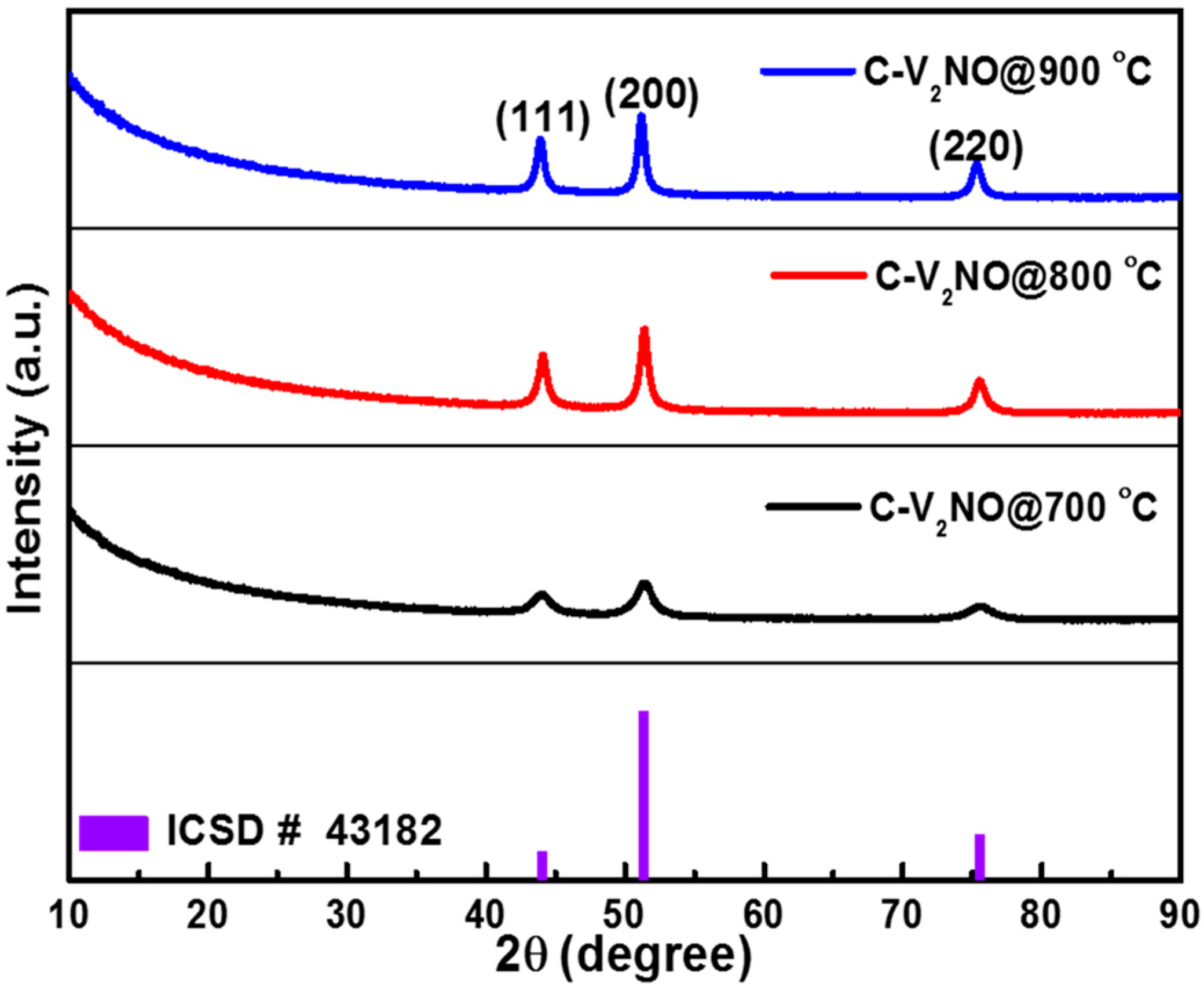
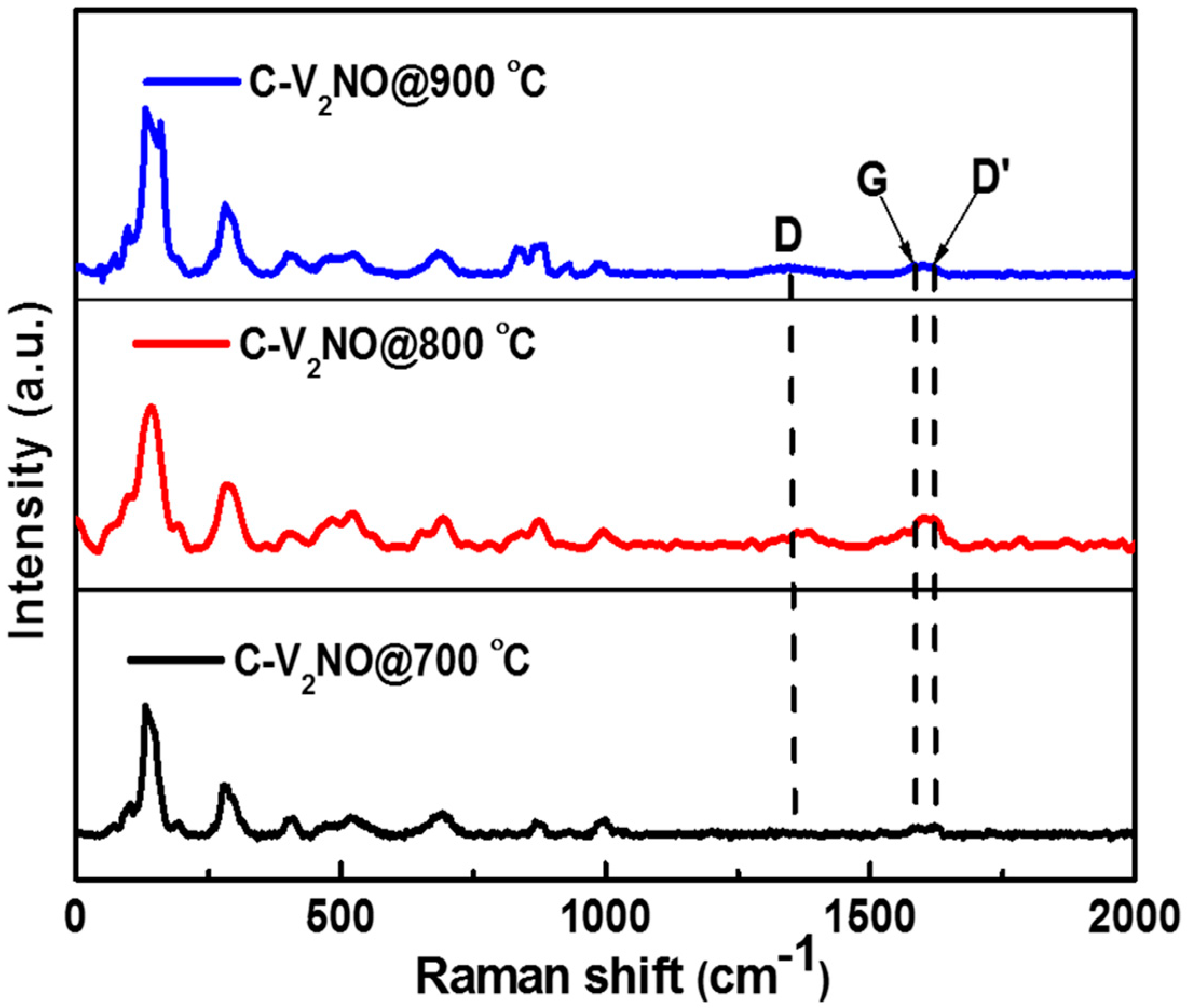

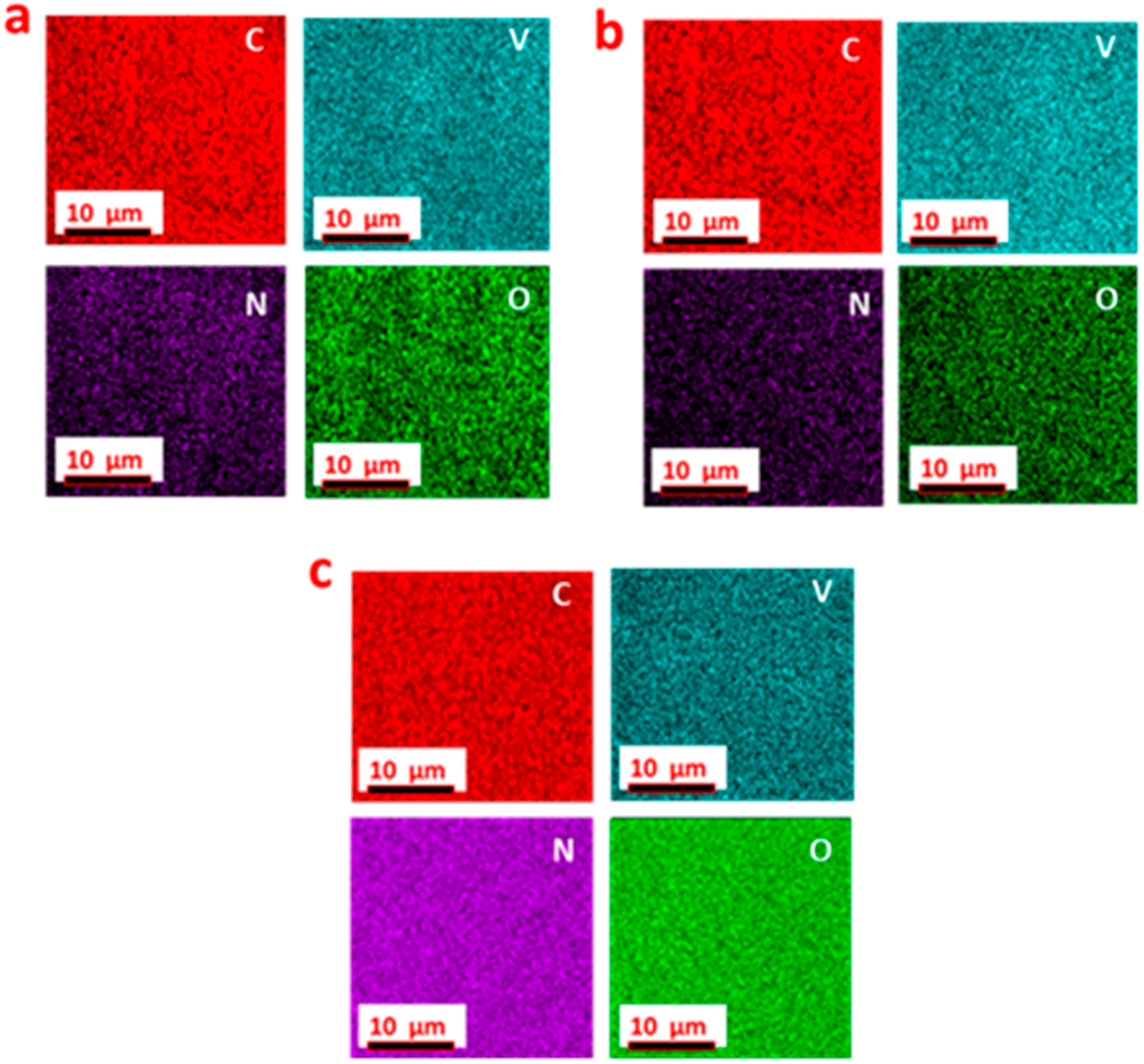
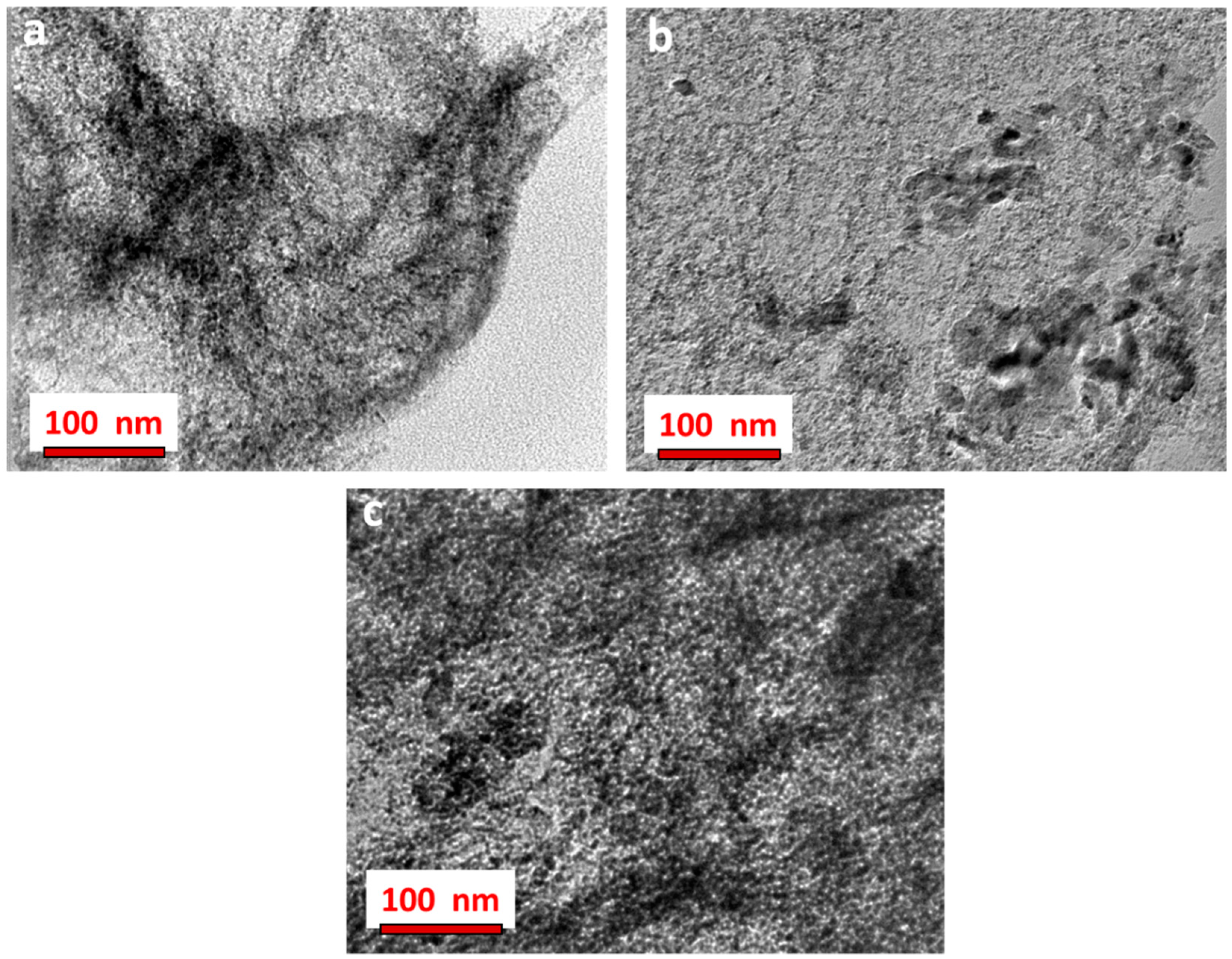
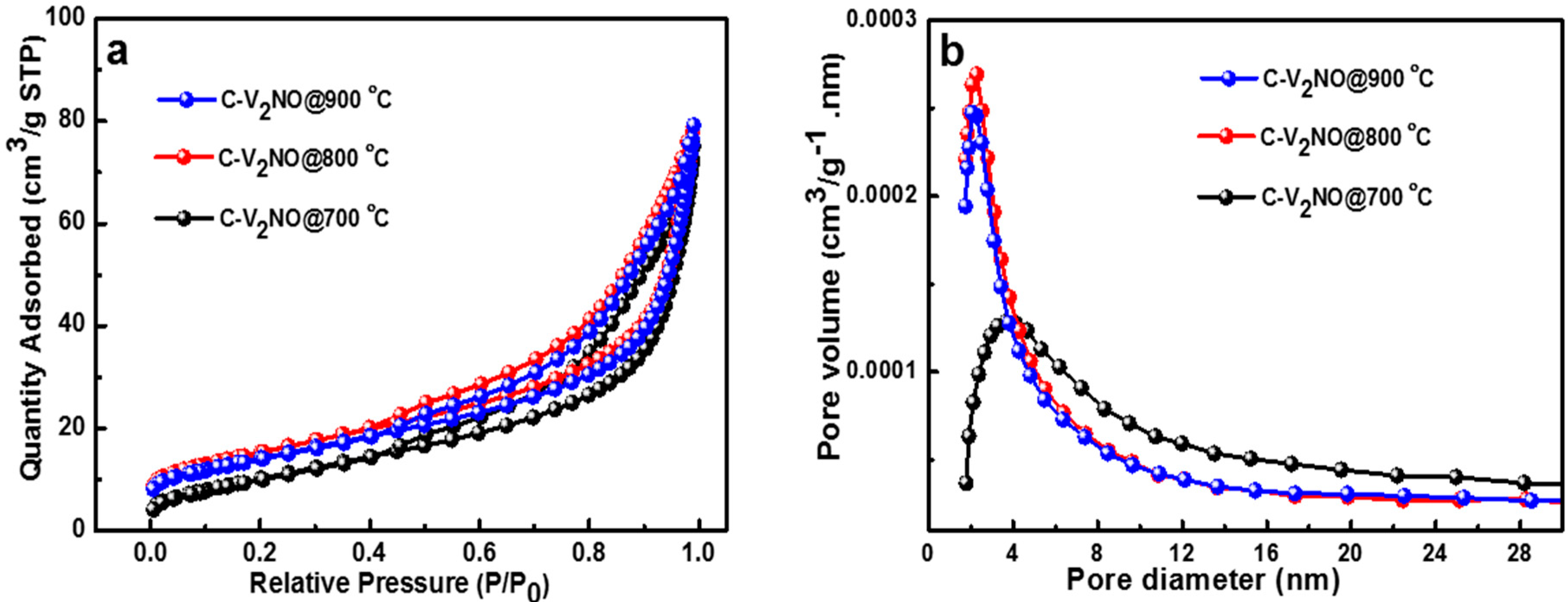
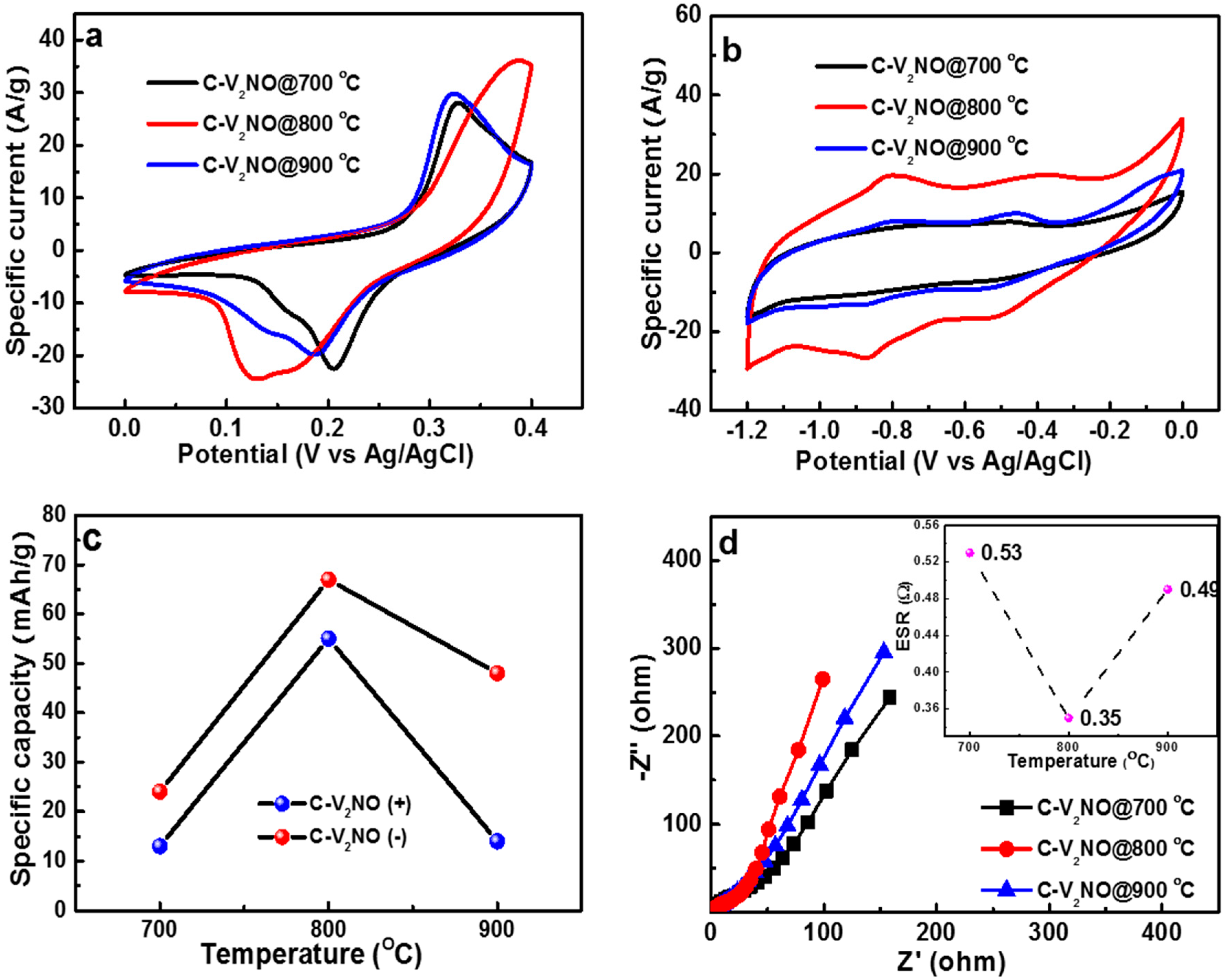
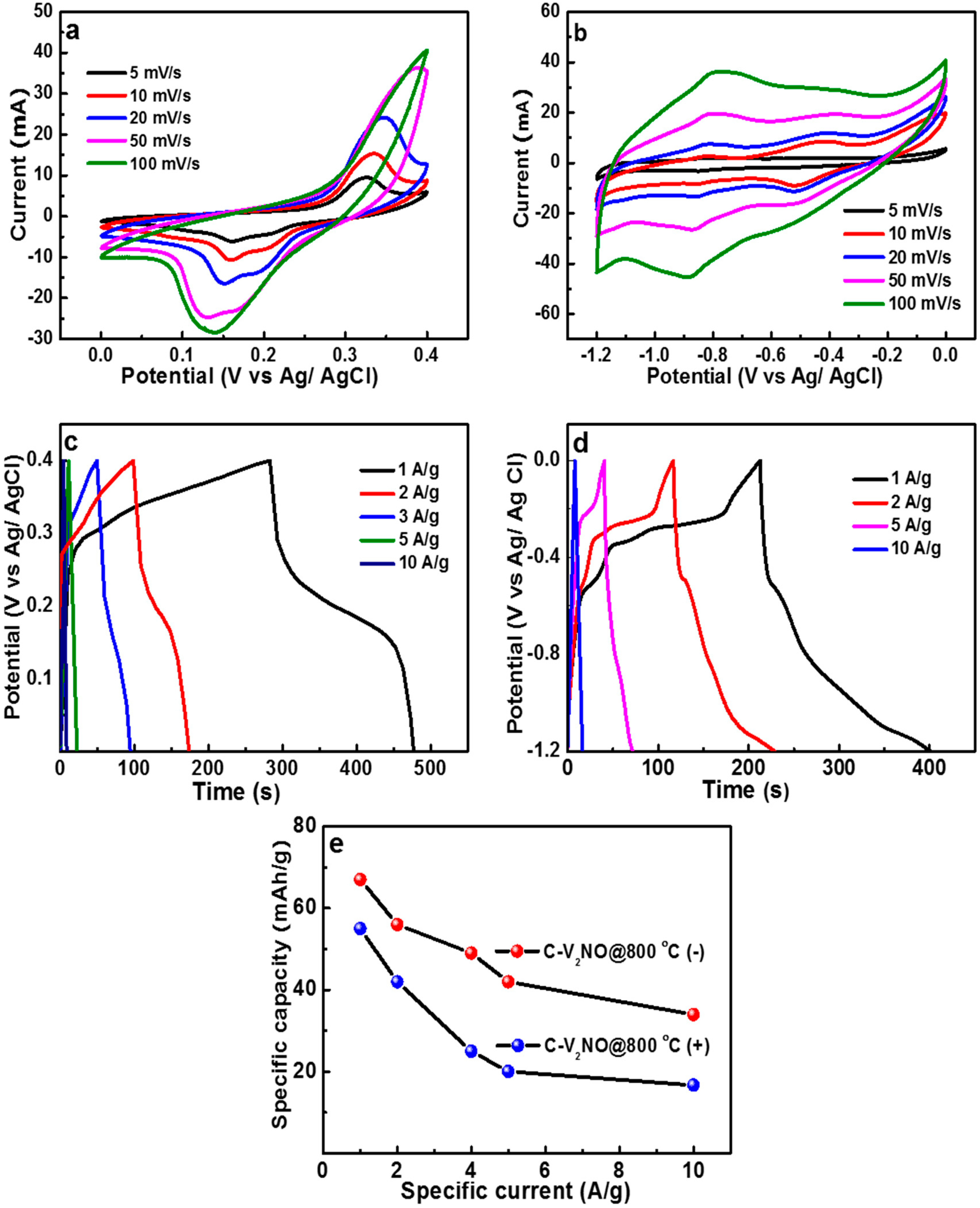
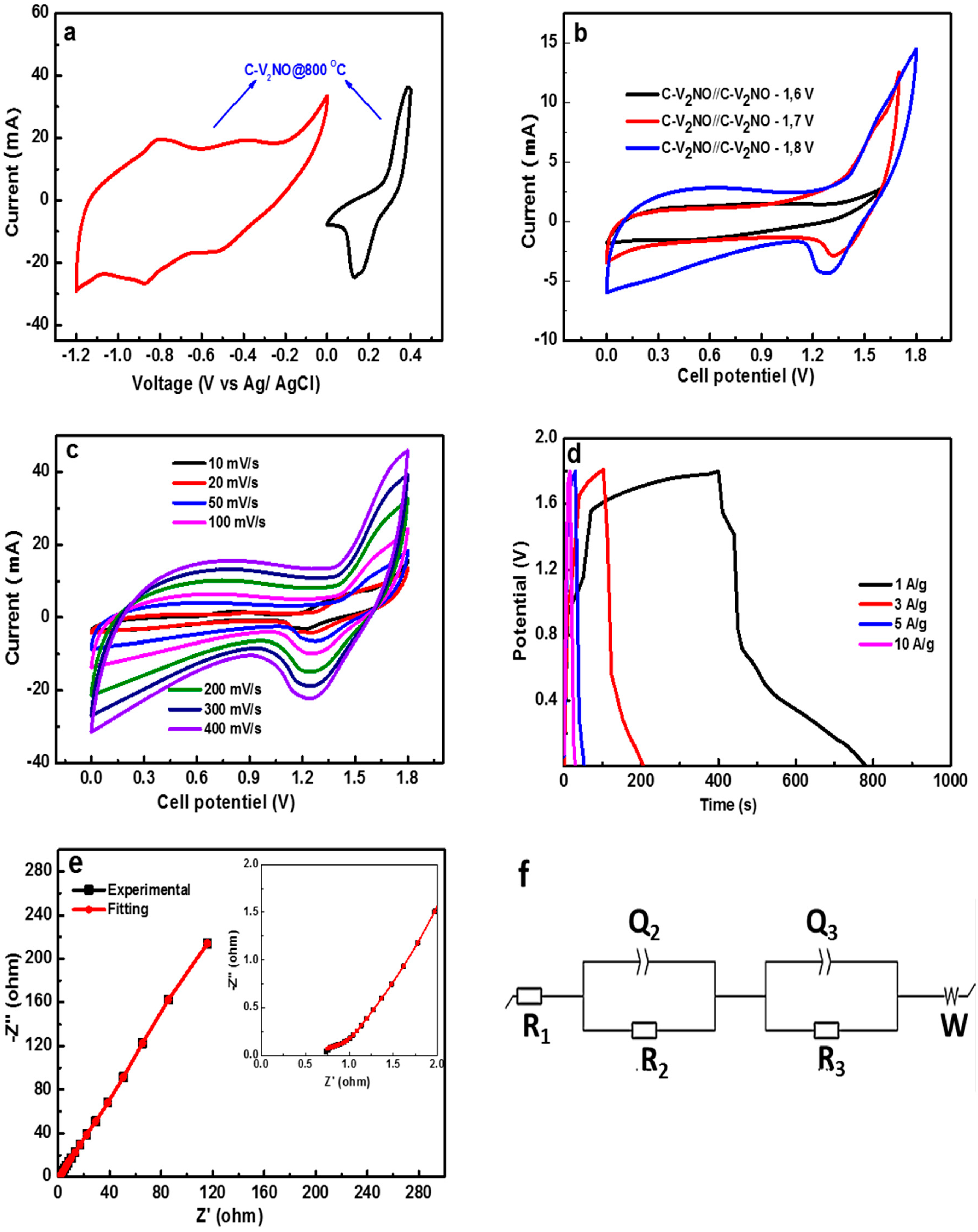
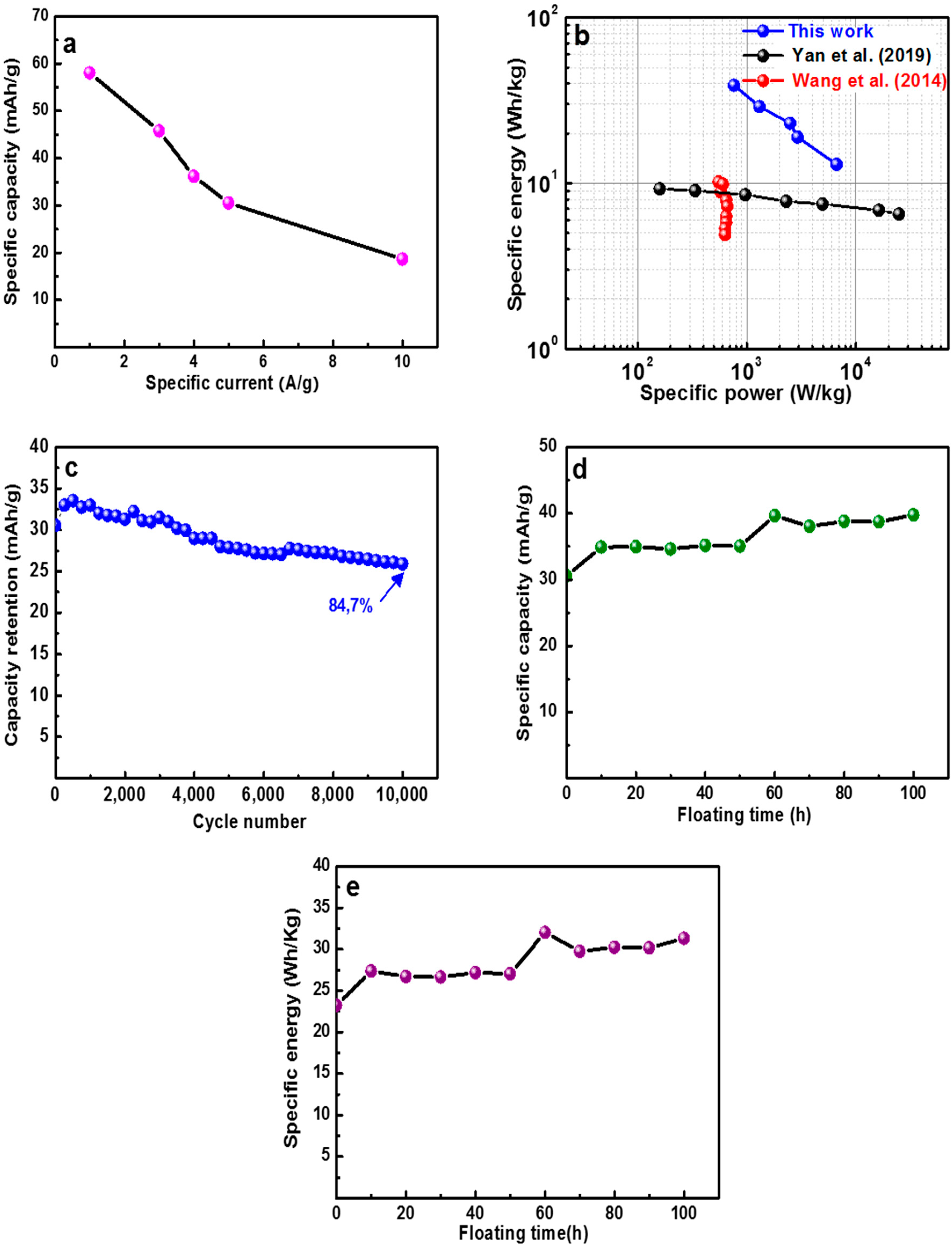
| Material | D Peak Position (cm−1) | G Peak Position (cm−1) | D’ Peak Position (cm−1) | ID/IG Ratio (±0.03) |
|---|---|---|---|---|
| C-V2NO@700 °C | 1349 | 1585 | 1611 | 0.47 |
| C-V2NO@800 °C | 1373 | 1593 | 1621 | 0.84 |
| C-V2NO@900 °C | 1346 | 1588 | 1618 | 0.56 |
| Material | C (Wt%) | V (Wt%) | N (Wt%) | O (Wt%) | Total |
|---|---|---|---|---|---|
| C-V2NO@700 °C | 62 | 17 | 5 | 16 | 100 |
| C-V2NO@800 °C | 66 | 11 | 9 | 14 | 100 |
| C-V2NO@900 °C | 64 | 18 | 7 | 11 | 100 |
© 2019 by the authors. Licensee MDPI, Basel, Switzerland. This article is an open access article distributed under the terms and conditions of the Creative Commons Attribution (CC BY) license (http://creativecommons.org/licenses/by/4.0/).
Share and Cite
Ndiaye, N.M.; Sylla, N.F.; Ngom, B.D.; Mutuma, B.K.; Dangbegnon, J.K.; Ray, S.C.; Manyala, N. Nitridation Temperature Effect on Carbon Vanadium Oxynitrides for a Symmetric Supercapacitor. Nanomaterials 2019, 9, 1762. https://doi.org/10.3390/nano9121762
Ndiaye NM, Sylla NF, Ngom BD, Mutuma BK, Dangbegnon JK, Ray SC, Manyala N. Nitridation Temperature Effect on Carbon Vanadium Oxynitrides for a Symmetric Supercapacitor. Nanomaterials. 2019; 9(12):1762. https://doi.org/10.3390/nano9121762
Chicago/Turabian StyleNdiaye, Ndeye M., Ndeye F. Sylla, Balla D. Ngom, Bridget K. Mutuma, Julien K. Dangbegnon, Sekhar C. Ray, and Ncholu Manyala. 2019. "Nitridation Temperature Effect on Carbon Vanadium Oxynitrides for a Symmetric Supercapacitor" Nanomaterials 9, no. 12: 1762. https://doi.org/10.3390/nano9121762
APA StyleNdiaye, N. M., Sylla, N. F., Ngom, B. D., Mutuma, B. K., Dangbegnon, J. K., Ray, S. C., & Manyala, N. (2019). Nitridation Temperature Effect on Carbon Vanadium Oxynitrides for a Symmetric Supercapacitor. Nanomaterials, 9(12), 1762. https://doi.org/10.3390/nano9121762






